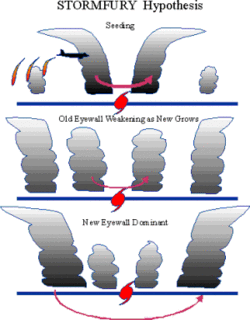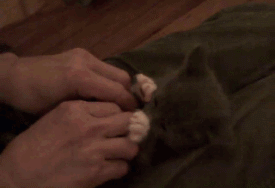Sporadic rantings every now and then....it gets good sometimes... most of the time its just random B.S.
Wednesday, August 31, 2011
Question.....
What do you think I should post ......?
Tuesday, August 30, 2011
Weather control
A tornado in central Oklahoma. Weather control researchers aspire to eliminate or control dangerous types of weather such as this.
Weather control is the act of manipulating or altering certain aspects of the environment to produce desirable changes in weather. Weather control can have the goal of preventing damaging weather, such as hurricanes or tornadoes, from occurring; of causing beneficial weather, such as rainfall in an area experiencing drought; or of provoking damaging weather against an enemy or rival, as a tactic of military or economic warfare. Weather modification in warfare has been banned by the United Nations.
Witches concoct a brew to summon a hailstorm.
In ancient India it is said that yajna or vedic rituals of chanting manthras and offering were performed by rishis to bring sudden bursts of rain fall in rain starved regions. Some American Indians like some Europeans had rituals which they believed could induce rain. The Finnish people, on the other hand, were believed by others to be able to control weather. As a result, Vikings refused to take Finns on their oceangoing raids. Remnants of this superstition lasted into the twentieth century, with some ship crews being reluctant to accept Finnish sailors. The early modern era saw people observe that during battles the firing of cannons and other firearms often initiated precipitation. Magical and religious practices to control the weather are attested in a variety of cultures.
In Greek mythology, Iphigenia was offered as a human sacrifice to appease the wrath of the goddess Artemis, who had becalmed the Achaean fleet at Aulis at the beginning of the Trojan War. In Homer's Odyssey, Aeolus, keeper of the winds, bestowed Odysseus and his crew with a gift of the four winds in a bag. However, the sailors opened the bag while Odysseus slept, looking for booty, and as a result were blown off course by the resulting gale. In ancient Rome, the lapis manalis was a sacred stone kept outside the walls of Rome in a temple of Mars. When Rome suffered from drought, the stone was dragged into the city. The Berwick witches of Scotland were found guilty of using black magic to summon storms to murder King James VI of Scotland by seeking to sink the ship upon which he travelled. Scandinavian witches allegedly claimed to sell the wind in bags or magically confined into wooden staves; they sold the bags to seamen who could release them when becalmed.In various towns of Navarre, prayers petitioned Saint Peter to grant rain in time of drought. If the rain was not forthcoming, the statue of St Peter was removed from the church and tossed into a river.
Perhaps the first example of practical weather control is the lightning rod. In the 1950s, computer scientist John von Neumann, an early theorizer on weather control, surmized that if Earth were to enter another ice age, a preventive solution would be to dump dirt (or spray soot from cropdusting planes) on the surface of the planet's glaciers. He noted that this would significantly change their reflectivity (albedo), and thus increase the solar energy retained by the planet. Such a strategy would require repeated applications, as storms would cover some portion of the soot with new snow until their frequency and range abated. The theoretical efficacy of von Neumann's proposal remains to be examined. Wilhelm Reich performed cloudbusting experiments in the 1950s to 1960s, the results of which are controversial and not widely accepted by mainstream science. Dr Walter Russell wrote of weather control in Atomic Suicide 1956. Jack Toyer in the 1970s built a rainmaker on Palmers Island near Grafton using a solar mirror, electromagnetic static charge, and infra red frequencies of light to induce weather in regional areas within Australia. His work was continued by his successor, Peter Stevens.
In January, 2011, several newspapers and magazines, including the UK's Sunday Times and Arabian Business, reported that scientists backed by the government of Abu Dhabi, the capital of the United Arab Emirates, had created over 50 artificial rainstorms between July and August of 2010 near Al Ain, a city which lies close to the country's border with Oman and is the second-largest city in the Abu Dhabi Emirate. The artificial rainstorms were said to have sometimes caused hail, gales and thunderstorms, baffling local residents. The scientists reportedly used ionizers to create the rainstorms, and although the results are disputed, the large number of times it is recorded to have rained right after the ionizers were switched on during a usually dry season is encouraging to those who support the experiment.
Cloud seeding for rain
Cloud seeding is a common technique to enhance precipitation. Evidence on its safety is strong, but there are still doubts about its effectiveness. Cloud seeding entails spraying small particles (like silver iodide) into the sky in order to trigger cloud formation. The hope is that the water vapor already in the air will condense onto the particles, forming clouds and eventually falling as rain. It is, of course, impossible to generate water through cloud seeding; cloud seeding only works to the extent that there is already water vapor present in the air. The principal goal is just to force precipitation to fall in one area instead of another. Critics generally contend that claimed successes occur in conditions which were going to rain anyway. It is used in a variety of drought-prone countries, including the United States, the People's Republic of China, India, and Russia. In the People's Republic of China there is a perceived dependency upon it in dry regions. In the United States, dry ice or silver iodide may be injected into a cloud by aircraft, or from the ground. In mountainous areas of the United States such as the Rocky Mountains and Sierra Nevada, it has been employed for several decades.
Project Stormfury
Storm prevention
Hail cannons at an international congress on hail shooting held in 1901
Project Stormfury was an attempt to weaken tropical cyclones by flying aircraft into storms and seeding the eyewall with silver iodide. The project was run by the United States Government from 1962 to 1983. A similar project using soot was run in 1958, with inconclusive results.
Various methods have been proposed to reduce the harmful effects of hurricanes. Moshe Alamaro of the Massachusetts Institute of Technology proposed using barges with upward-pointing jet engines to trigger smaller storms to disrupt the progress of an incoming hurricane; critics doubt the jets would be powerful enough to make any noticeable difference.
Alexandre Chorin of the University of California, Berkeley proposed dropping large amounts of environmentally friendly oils on the sea surface to prevent droplet formation.Experiments by Kerry Emanuel of MIT in 2002 suggested that hurricane-force winds would disrupt the oil slick, making it ineffective. Other scientists disputed the factual basis of the theoretical mechanism assumed by this approach. The Florida company Dyn-O-Mat proposes the use of a product it has developed, called Dyn-O-Gel, to reduce the strength of hurricanes. The substance is a polymer in powder form which reportedly has the ability to absorb 1,500 times its own weight in water. The theory is that the polymer is dropped into clouds to remove their moisture and force the storm to use more energy to move the heavier water drops, thus helping to dissipate the storm. When the gel reaches the ocean surface, it is reportedly dissolved. The company has tested the substance on a thunderstorm, but there has not been any scientific consensus established as to its effectiveness.
Hail cannons are used by some farmers in an attempt to ward off hail, but there is no reliable scientific evidence to confirm their effectiveness. Another new anti-hurricane technology is a method for the reduction of tropical cyclones’ destructive force - pumping sea water into and diffusing it in the wind at the bottom of such tropical cyclone in its eye-wall.
Hurricane modification
Various ideas for manipulating hurricanes have been suggested.
One TV show explored various ideas such as:
Using lasers to discharge lightning in storms which are likely to become hurricanes
Pouring liquid nitrogen onto the sea to deprive the hurricane of heat energy.
Creating soot to absorb sunlight and change air temperature and hence convection currents in the outer wall.
Weather control and law
US and Canada agreement
In 1975, the US and Canada entered into an agreement under the auspices of the United Nations for the exchange of information on weather modification activity.
1977 UN Environmental Modification Convention
Environmental Modification Convention
Weather control, particularly hostile weather warfare, was addressed by the "United Nations General Assembly Resolution 31/72, TIAS 9614 Convention on the Prohibition of Military or Any Other Hostile Use of Environmental Modification Techniques" was adopted. The Convention was: Signed in Geneva May 18, 1977; Entered into force October 5, 1978; Ratification by U.S. President December 13, 1979; U.S. ratification deposited at New York January 17, 1980.
US National Oceanic and Atmospheric Administration
In the US, the National Oceanic and Atmospheric Administration regulates weather control projects, under authority of Public Law 205 of the 92nd Congress.
US Legislation
The Space Preservation Act was proposed "to preserve the cooperative, peaceful uses of space for the benefit of all humankind by permanently prohibiting the basing of weapons in space by the United States, and to require the President to take action to adopt and implement a world treaty banning space-based weapons."
2005 U.S. Senate Bill 517 and U.S. House Bill 2995 U.S. Senate Bill 517 and U.S. House Bill 2995 were two bills proposed in 2005 that would have expanded experimental weather modification, to establish a Weather Modification Operations and Research Board, and implemented a national weather modification policy. Neither were made into law. Former Texas State Senator John N. Leedom was the key lobbyist on behalf of the weather modification bills.
2007 U.S. Senate Bill 1807 & U.S. House Bill 3445 Senate Bill 1807 and House Bill 3445, identical bills introduced July 17, 2007, proposed to establish a Weather Mitigation Advisory and Research Board to fund weather modification research
Future aspirations
Climatologists have simulated hurricane control based on selective heating and cooling (or prevention of evaporation). Futurist John Smart has discussed the potential for weather control via space-based solar power networks. One proposal involves the gentle heating via microwave of portions of large hurricanes. Such chaotic systems may be susceptible to "side steering" with a few degrees of increased temperature/pressure at critical points. A sufficient network might keep the largest and most potentially damaging hurricanes from landfall, at the request of host nations. Blizzards, monsoons, and other extreme weather are also potential candidates for space-based amelioration. If large-scale weather control were to become feasible, potential negative implications may include:
Unintended side effects, especially given the chaotic nature of weather development
Damage to existing ecosystems
Health risks to humans
Equipment malfunction or accidents
Non-democratic control or use as a weapon
ELF hot spots causing slightly accelerated ionospheric depletion by solar wind
For the 2008 Olympics, China had 30 airplanes, 4,000 rocket launchers, and 7,000 anti-aircraft guns to stop rain. Each system would shoot various chemicals into any threatening clouds to shrink rain drops before they reach the stadium.
A Project HAARP antenna
Project Stormfury crew
Conspiracy theorists question the possibility of using weather control as a weapon (e.g. via HAARP and/or chemtrails), At a counterterrorism conference in 1997, United States Secretary of Defense William Cohen referred to the writings of futurist Alvin Toffler, specifically regarding concerns about "environmental terrorism" and intentionally caused natural disasters.
See also
High Frequency Active Auroral Research Program (HAARP)
Weather Modification Operations and Research Board
Global warming
Geoengineering
Weather forecasting
Hail cannon
Operation Popeye
Beijing Weather Modification Office
Bernard Eastlund
Project Cumulus
Alberta Hail Project
Chemtrail conspiracy theory
Monday, August 29, 2011
Sunday, August 28, 2011
“Watch your thoughts, they become words.
Watch your words, they lead to actions.
Watch your actions, they create habits.
Watch your habits, they build your character.
Watch your character, it becomes your destiny.”
Saturday, August 27, 2011
High-speed filter uses electrified nanostructures to purify water at low cost
Stanford researchers have developed a water-purifying filter that makes the process more than 80,000 times faster than existing filters. The key is coating the filter fabric – ordinary cotton – with nanotubes and silver nanowires, then electrifying it. The filter uses very little power, has no moving parts and could be used throughout the developing world.
Courtesy of Yi Cui
A scanning electron microscope image of the silver nanowires in which the cotton is dipped during the process of constructing a filter. The large fibers are cotton.
BY LOUIS BERGERON
By dipping plain cotton cloth in a high-tech broth full of silver nanowires and carbon nanotubes, Stanford researchers have developed a new high-speed, low-cost filter that could easily be implemented to purify water in the developing world.
Instead of physically trapping bacteria as most existing filters do, the new filter lets them flow on through with the water. But by the time the pathogens have passed through, they have also passed on, because the device kills them with an electrical field that runs through the highly conductive "nano-coated" cotton.
In lab tests, over 98 percent of Escherichia coli bacteria that were exposed to 20 volts of electricity in the filter for several seconds were killed. Multiple layers of fabric were used to make the filter 2.5 inches thick.
"This really provides a new water treatment method to kill pathogens," said Yi Cui, an associate professor of materials science and engineering. "It can easily be used in remote areas where people don't have access to chemical treatments such as chlorine."
Cholera, typhoid and hepatitis are among the waterborne diseases that are a continuing problem in the developing world. Cui said the new filter could be used in water purification systems from cities to small villages.
Faster filtering by letting bacteria through
Filters that physically trap bacteria must have pore spaces small enough to keep the pathogens from slipping through, but that restricts the filters' flow rate.
Since the new filter doesn't trap bacteria, it can have much larger pores, allowing water to speed through at a more rapid rate.
"Our filter is about 80,000 times faster than filters that trap bacteria," Cui said. He is the senior author of a paper describing the research that will be published in an upcoming issue of Nano Letters. The paper is available online now.
The larger pore spaces in Cui's filter also keep it from getting clogged, which is a problem with filters that physically pull bacteria out of the water.
Cui's research group teamed with that of Sarah Heilshorn, an assistant professor of materials science and engineering, whose group brought its bioengineering expertise to bear on designing the filters.
Brian Caslis
Professor of Materials Science and Engineering Yi Cui
Silver has long been known to have chemical properties that kill bacteria. "In the days before pasteurization and refrigeration, people would sometimes drop silver dollars into milk bottles to combat bacteria, or even swallow it," Heilshorn said.
Cui's group knew from previous projects that carbon nanotubes were good electrical conductors, so the researchers reasoned the two materials in concert would be effective against bacteria. "This approach really takes silver out of the folk remedy realm and into a high-tech setting, where it is much more effective," Heilshorn said.
Using the commonplace keeps costs down
But the scientists also wanted to design the filters to be as inexpensive as possible. The amount of silver used for the nanowires was so small the cost was negligible, Cui said. Still, they needed a foundation material that was "cheap, widely available and chemically and mechanically robust." So they went with ordinary woven cotton fabric.
"We got it at Wal-mart," Cui said.
To turn their discount store cotton into a filter, they dipped it into a solution of carbon nanotubes, let it dry, then dipped it into the silver nanowire solution. They also tried mixing both nanomaterials together and doing a single dunk, which also worked. They let the cotton soak for at least a few minutes, sometimes up to 20, but that was all it took.
The big advantage of the nanomaterials is that their small size makes it easier for them to stick to the cotton, Cui said. The nanowires range from 40 to 100 billionths of a meter in diameter and up to 10 millionths of a meter in length. The nanotubes were only a few millionths of a meter long and as narrow as a single billionth of a meter. Because the nanomaterials stick so well, the nanotubes create a smooth, continuous surface on the cotton fibers. The longer nanowires generally have one end attached with the nanotubes and the other end branching off, poking into the void space between cotton fibers.
"With a continuous structure along the length, you can move the electrons very efficiently and really make the filter very conducting," he said. "That means the filter requires less voltage."
Minimal electricity required
The electrical current that helps do the killing is only a few milliamperes strong – barely enough to cause a tingling sensation in a person and easily supplied by a small solar panel or a couple 12-volt car batteries. The electrical current can also be generated from a stationary bicycle or by a hand-cranked device.
The low electricity requirement of the new filter is another advantage over those that physically filter bacteria, which use electric pumps to force water through their tiny pores. Those pumps take a lot of electricity to operate, Cui said.
In some of the lab tests of the nano-filter, the electricity needed to run current through the filter was only a fifth of what a filtration pump would have needed to filter a comparable amount of water.
The pores in the nano-filter are large enough that no pumping is needed – the force of gravity is enough to send the water speeding through.
Although the new filter is designed to let bacteria pass through, an added advantage of using the silver nanowire is that if any bacteria were to linger, the silver would likely kill it. This avoids biofouling, in which bacteria form a film on a filter. Biofouling is a common problem in filters that use small pores to filter out bacteria.
Cui said the electricity passing through the conducting filter may also be altering the pH of the water near the filter surface, which could add to its lethality toward the bacteria.
Cui said the next steps in the research are to try the filter on different types of bacteria and to run tests using several successive filters.
"With one filter, we can kill 98 percent of the bacteria," Cui said. "For drinking water, you don't want any live bacteria in the water, so we will have to use multiple filter stages."
Cui's research group has gained attention recently for using nanomaterials to build batteries from paper and cloth.
David Schoen and Alia Schoen were both graduate students in Materials Science and Engineering when the water-filter research was conducted and are co–lead authors of the paper in Nano Letters. David Schoen is now a postdoctoral researcher at Stanford.
Liangbing Hu, a postdoctoral researcher in Materials Science and Engineering, and Han Sun Kim, a graduate student in Materials Science and Engineering at the time the research was conducted, also contributed to the research and are co-authors of the paper.
The research was funded by the King Abdullah University of Science and Technology (KAUST).
Friday, August 26, 2011
WTF?
Why was there an exhibit for the United Nations at Rockefeller plaza ??
Tron
so I've been reading varying texts, and interviews with various unmentionable persons "HH" and come fully to the conclusion that Tron was one of the best ideological representations of what life really is and it was so blatant in its form, but we never did grasp the concept in its entirety, just watch Tron and contemplate the meaning of things, I'm sure you'll get it sooner or later...
"What I want, is that my words become a Catalyst for you. That is what we came here to do. If my words cause you, even if for just a short time, to stop for a moment, and evaluate that which you 'think' you already know about the nature of Life, and take for granted as being true (because "everyone else believes it"), then my time will have been well spent. My desire is that you become an Authentic Human Being, thinking, and feeling, and deciding for yourself what "feels" like Truth for you. I wish you well in your endeavors."
H.H.
Thursday, August 25, 2011
Wednesday, August 24, 2011
Steve Wozniak: "We're going to become the pets, the dogs of the house."
Machines have won the war and the human race is destined to become little more than house pets.
That's the future according to one of the smartest geeks on the planet, Steve Wozniak, who co-founded Apple Computers and is convinced that in his lifetime he will see computer intelligence equal that of humans.
Read More here...
Machines have won the war and the human race is destined to become little more than house pets.
That's the future according to one of the smartest geeks on the planet, Steve Wozniak, who co-founded Apple Computers and is convinced that in his lifetime he will see computer intelligence equal that of humans.
Read More here...
Tuesday, August 23, 2011
http://www.stumbleupon.com/su/6ai2h5/mastersystem8.com/toplist/more/
Monday, August 22, 2011
Sunday, August 21, 2011
Saturday, August 20, 2011
Friday, August 19, 2011
Thursday, August 18, 2011
Wednesday, August 17, 2011
Tuesday, August 16, 2011
Subscribe to:
Posts (Atom)


















































